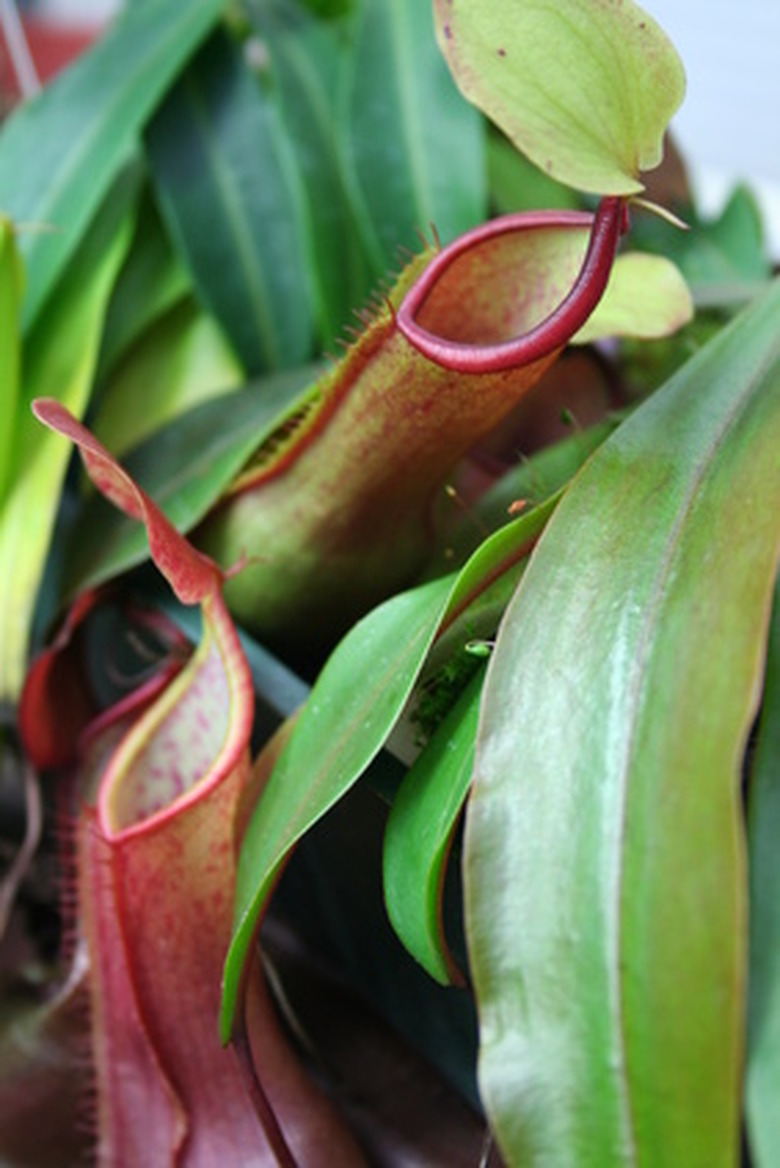How To Care For A Nepenthes Asian Pitcher Plant
Things Needed
- 6-inch pot
- Orchid potting soil
- Perlite
- Orchid bark
- Peat moss
- Knife
- Scissors
- Water
- Insects
- Greenhouse
- Terrarium
The nepenthes genus of Asian pitcher plants consists of two main varieties: highland and lowland. Most highland varieties are fairly easy to grow indoors without the aid of a terrarium. Lowland varieties require the high humidity levels of a terrarium or greenhouse and are generally more difficult to grow. If this is your first experience with these carnivorous pitcher plants, the best type to start with is an easy-to-grow highland variety like Nepenthes sanguinea or Nepenthes hamata.
Step 1
Fill a 6-inch container (hanging planters are ideal) to within 1 inch of its rim with potting mix. Nepenthes adapts well to a wide range of low-fertility, well-drained potting mixes. The Carnivorous Plant Nursery recommends a soil mix designed for orchids or a 1-1-1 mixture of perlite, orchid bark and peat moss mix.
- The nepenthes genus of Asian pitcher plants consists of two main varieties: highland and lowland.
- The Carnivorous Plant Nursery recommends a soil mix designed for orchids or a 1-1-1 mixture of perlite, orchid bark and peat moss mix.
Step 2
Plant your Asian pitcher plant in the planter at the same depth that it was growing in its original container. Take care not to damage its roots when removing it from its original container. The best method is to cut away the plastic container with scissors or a sharp knife; then peel it away from the root ball. Mind the roots when planting as well: carefully scoop the planting medium around the plant's roots and shake the pot to settle it. Do not firm the medium down with your hands. Water the plant immediately after you pot it.
Step 3
Hang or place highland pitcher plants near a sunny window or outdoors if it is warm enough. A half day's early southern sun (at least four hours) and dappled, partial shade during the hottest part of the day is ideal for most species of nepenthes. Lowland pitcher plants must be kept in a greenhouse or terrarium.
- Plant your Asian pitcher plant in the planter at the same depth that it was growing in its original container.
- Mind the roots when planting as well: carefully scoop the planting medium around the plant's roots and shake the pot to settle it.
Step 4
Fill each individual pitcher with 1/2 to 3/4 inches of water once you have it transplanted and settled in its new home. During transport, pitchers loose some of their fluid and may dry out and die if not hydrated. You will only have to do this once.
Step 5
Water your nepenthes frequently enough to keep the soil consistently moist. Each time you water, fill the container until water comes out of the drainage holes in its bottom. Check the water's moisture level at least once daily.The best water to use is collected rainwater. If that is unavailable, use distilled or purified water.
- Fill each individual pitcher with 1/2 to 3/4 inches of water once you have it transplanted and settled in its new home.
- Water your nepenthes frequently enough to keep the soil consistently moist.
Step 6
Keep your nepenthes' surrounding temperature between 55 and 95 degrees Fahrenheit. Some species of Asian pitcher plant (especially highlanders) like it cooler than others. If your nepenthes is growing new leaves that are smaller than its older ones, it needs cooler temperatures at night. Lowland nepenthes need warmer nighttime temperatures. They will tolerate the occasional dip below 70 degrees F but prolonged exposure slows their growth and makes them prone to disease. Never expose your nepenthes to temperatures below 40 degrees F.
Step 7
Feed your nepenthes as little as possible. Asian pitcher plants have evolved to survive on a minimal amount of food. And even indoor-grown pitcher plants can catch enough insects to survive. If your pitcher plant is sealed in a terrarium or other place where there are no insects, feed it no more than one or two dead insects per month. Never feed it insects that have been killed with pesticides.
- Keep your nepenthes' surrounding temperature between 55 and 95 degrees Fahrenheit.
- If your nepenthes is growing new leaves that are smaller than its older ones, it needs cooler temperatures at night.
Step 8
Prune dead pitchers and leaves. To encourage your nepenthes to take on a fuller shape, prune back any green stems that stretch out. Or train them up a stake or trellis. Do not prune more than 1/3 of the plant's foliage at any time. If you do not want your female pitcher plant to produce seeds, remove its flower spikes. They zap the plant's energy and produce an unpleasant smell.
Step 9
Repot your Asian pitcher plant in a pot that is 1 inch larger than its old pot every year. Replace the soil whenever you repot. You can repot at any time of the year.
- Prune dead pitchers and leaves.
- To encourage your nepenthes to take on a fuller shape, prune back any green stems that stretch out.
Tip
Keep the room humid. Highland nepenthes can survive in dry conditions, but they will have trouble keeping nectar in their pitchers. If your pitcher plant stops producing pitchers, it needs more humidity. Mist the plant with water daily or place the pot on top of a planting tray filled with pebbles and then water. As the water evaporates it will increase the humidity of the air adjacent to your plant. If your nepenthes' leaves look burned or turn yellow, it is receiving too much direct sunlight.
